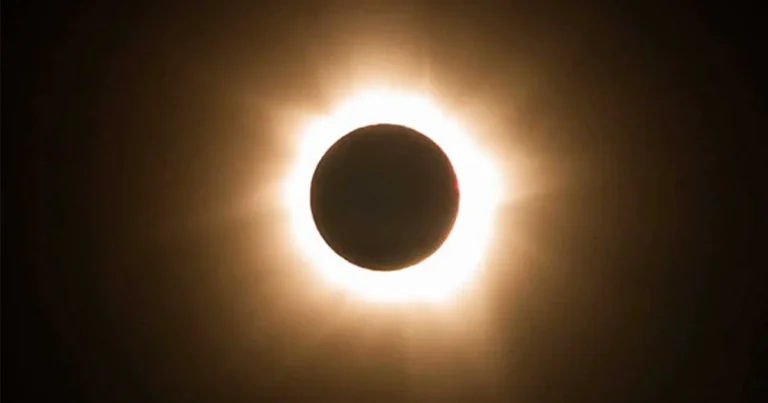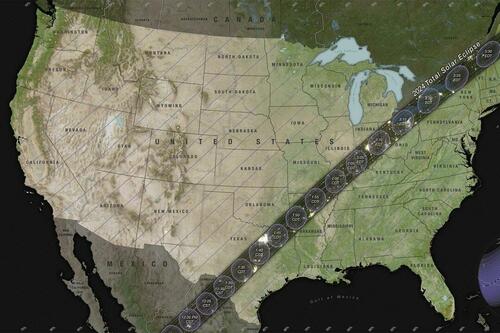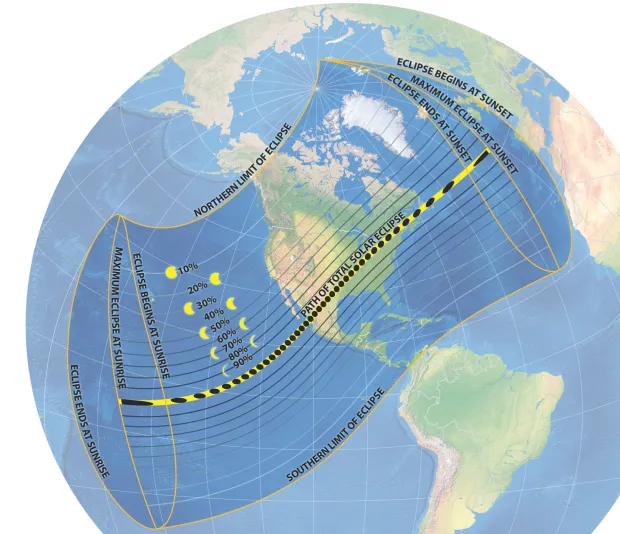FAA warns of air travel disruption for next solar eclipse

The Federal Aviation Administration (FAA) issued a warning Thursday about potential disruptions to air travel amid the upcoming total solar eclipse on April 8.

A text-free graphical visualization of the path of totality and partial contours crossing the United States for the 2024 total solar eclipse occurring on April 8, 2024. (Courtesy of NASA's Scientific Visualization Studio)
According to the aviation agency, the celestial event, which will span a path of totality across 13 states, will impact air travel operations before, during and after the eclipse.
The FAA has indicated that the effects of the eclipse on US airspace are expected between approximately 2.30pm and 3.40pm. At that time, about 32 million people in North America are expected to witness the rare event, which is expected to be the most-watched solar eclipse in history.
A total solar eclipse occurs when the new moon passes directly in front of the sun, completely blocking sunlight and casting the moon's shadow on the Earth's surface. The most recent total solar eclipse to occur on American soil was the Great American Eclipse of 2017.
An advisory issued by the FAA to aviators highlights the potential impacts on air traffic and airports in the path of the eclipse from April 7-10. Pilots and aviation personnel are urged to stay informed and prepared for possible disruptions.
In a statement, the FAA advised aircraft to prepare for potential departure delays, diversions and departure clearance times that may be issued for all domestic IFR arrivals and departures during the eclipse.
Aircraft departing from airports along the path of the eclipse are “strongly encouraged” to coordinate their departure times as soon as possible, to help fixed base operators fine-tune aircraft and ease ramp congestion.
“Higher than normal traffic volumes may be expected at airports along the path of the eclipse. Traffic should expect delays during peak traffic,” the FAA said.
The agency warned that parking for planes may be limited, especially at small, uncontrolled airports. There may also be delays in issuing authorizations for IFR departures.
“VFR departures may also include delays for in-flight collection of IFR clearances within 50 NM on either side of the eclipse path,” the FAA said.
The eclipse will also impact or perhaps prohibit aircraft from conducting test approaches, touch-and-go operations, flight following services and pilot training at airports during the event.
“Aircraft should carefully check NOTAMs for special procedures/restrictions that may be in place at affected airports. Specific NOTAM procedures may be revised and arrivals at some airports may be limited, so we encourage you to check NOTAMs frequently to ensure you have up-to-date information,” the agency advised.
'Great North American Eclipse'
Dubbed the “Great North American Eclipse,” the celestial event is expected to be more impressive than 2017's, as it will last longer, be larger and pass through more populated parts of North America.
On April 8, it will begin over the South Pacific Ocean and move into North America, crossing Mexico, the United States and Canada. The 2024 event will move in a different direction than the 2017 event, marking a cross on the United States.
The Moon's shadow will create a relatively narrow ribbon – the path of totality – about 100 miles across the Earth's surface. To experience a 100 percent total solar eclipse, viewers will need to be in this narrow band. This will reveal “the star's outer atmosphere, called the corona,” according to NASA.
Totality will last more than four minutes in some parts of the United States.
According to NASA, the eclipse's path will pass through Oklahoma, Arkansas, Missouri, Illinois, Kentucky, Indiana, Ohio, Pennsylvania, New York, Vermont, New Hampshire and Maine. Small areas of Tennessee and Michigan will also experience the total solar eclipse.
The eclipse will enter Canada in southern Ontario, pass through Quebec, New Brunswick, Prince Edward Island and Cape Breton before exiting mainland North America on the Atlantic coast of Newfoundland at 5.16pm, according to NASA.
For this event, the FAA said special safety provisions may apply, including temporary flight restrictions, two-way radio communications and discrete transponder requirements.
“Specific NOTAM procedures may be revised and arrivals at some airports may be limited, so we encourage you to review NOTAMs frequently to ensure you have current information,” the FAA reiterated.

Thanks to our Telegram channel you can stay updated on the publication of new Economic Scenarios articles.
The article FAA warns of air travel disruption for next solar eclipse comes from Economic Scenarios .
This is a machine translation of a post published on Scenari Economici at the URL https://scenarieconomici.it/la-faa-mette-in-guardia-da-interruzione-dei-viaggi-aerei-per-la-prossima-eclisse-solare/ on Sat, 23 Mar 2024 10:31:39 +0000.

